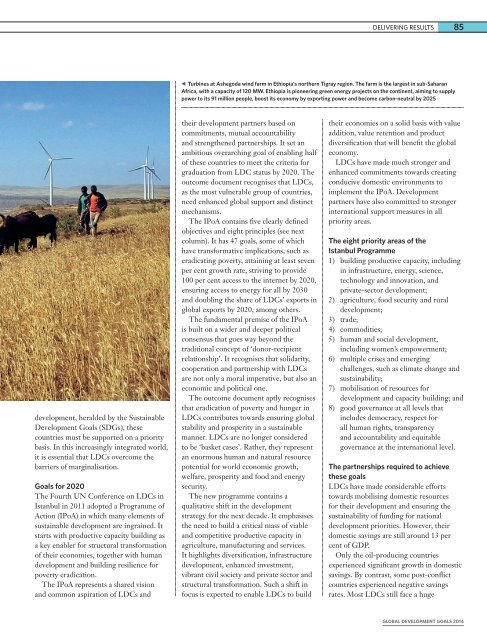FAMBB
FAMBB
FAMBB
Create successful ePaper yourself
Turn your PDF publications into a flip-book with our unique Google optimized e-Paper software.
DELIVERING RESULTS85Turbines at Ashegoda wind farm in Ethiopia’s northern Tigray region. The farm is the largest in sub-SaharanAfrica, with a capacity of 120 MW. Ethiopia is pioneering green energy projects on the continent, aiming to supplypower to its 91 million people, boost its economy by exporting power and become carbon-neutral by 2025development, heralded by the SustainableDevelopment Goals (SDGs), thesecountries must be supported on a prioritybasis. In this increasingly integrated world,it is essential that LDCs overcome thebarriers of marginalisation.Goals for 2020The Fourth UN Conference on LDCs inIstanbul in 2011 adopted a Programme ofAction (IPoA) in which many elements ofsustainable development are ingrained. Itstarts with productive capacity building asa key enabler for structural transformationof their economies, together with humandevelopment and building resilience forpoverty eradication.The IPoA represents a shared visionand common aspiration of LDCs andtheir development partners based oncommitments, mutual accountabilityand strengthened partnerships. It set anambitious overarching goal of enabling halfof these countries to meet the criteria forgraduation from LDC status by 2020. Theoutcome document recognises that LDCs,as the most vulnerable group of countries,need enhanced global support and distinctmechanisms.The IPoA contains five clearly definedobjectives and eight principles (see nextcolumn). It has 47 goals, some of whichhave transformative implications, such aseradicating poverty, attaining at least sevenper cent growth rate, striving to provide100 per cent access to the internet by 2020,ensuring access to energy for all by 2030and doubling the share of LDCs’ exports inglobal exports by 2020, among others.The fundamental premise of the IPoAis built on a wider and deeper politicalconsensus that goes way beyond thetraditional concept of ‘donor-recipientrelationship’. It recognises that solidarity,cooperation and partnership with LDCsare not only a moral imperative, but also aneconomic and political one.The outcome document aptly recognisesthat eradication of poverty and hunger inLDCs contributes towards ensuring globalstability and prosperity in a sustainablemanner. LDCs are no longer consideredto be ‘basket cases’. Rather, they representan enormous human and natural resourcepotential for world economic growth,welfare, prosperity and food and energysecurity.The new programme contains aqualitative shift in the developmentstrategy for the next decade. It emphasisesthe need to build a critical mass of viableand competitive productive capacity inagriculture, manufacturing and services.It highlights diversification, infrastructuredevelopment, enhanced investment,vibrant civil society and private sector andstructural transformation. Such a shift infocus is expected to enable LDCs to buildtheir economies on a solid basis with valueaddition, value retention and productdiversification that will benefit the globaleconomy.LDCs have made much stronger andenhanced commitments towards creatingconducive domestic environments toimplement the IPoA. Developmentpartners have also committed to strongerinternational support measures in allpriority areas.The eight priority areas of theIstanbul Programme1) building productive capacity, includingin infrastructure, energy, science,technology and innovation, andprivate-sector development;2) agriculture, food security and ruraldevelopment;3) trade;4) commodities;5) human and social development,including women’s empowerment;6) multiple crises and emergingchallenges, such as climate change andsustainability;7) mobilisation of resources fordevelopment and capacity building; and8) good governance at all levels thatincludes democracy, respect forall human rights, transparencyand accountability and equitablegovernance at the international level.The partnerships required to achievethese goalsLDCs have made considerable effortstowards mobilising domestic resourcesfor their development and ensuring thesustainability of funding for nationaldevelopment priorities. However, theirdomestic savings are still around 13 percent of GDP.Only the oil-producing countriesexperienced significant growth in domesticsavings. By contrast, some post-conflictcountries experienced negative savingsrates. Most LDCs still face a hugeGLOBAL DEVELOPMENT GOALS 2014


